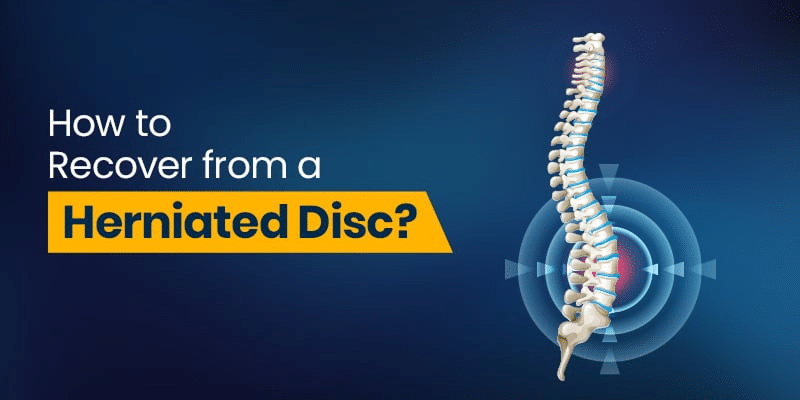Understanding a Herniated Disc
A herniated disc occurs when the soft inner material of a spinal disc pushes through a tear in the outer layer, causing discomfort, pain, or nerve compression. This condition is also referred to as a slipped or ruptured disc and commonly affects the lower back (lumbar spine) and neck (cervical spine). While it can be painful, the good news is that most people recover without surgery through proper treatment, exercises, and lifestyle changes.
If you’re dealing with a herniated disc, understanding its causes, symptoms, and recovery methods can help you get back to a pain-free life. Let’s explore the best ways to heal and prevent future spine issues.
Causes and Symptoms of a Herniated Disc
Common Causes
Herniated discs can develop due to:
- Aging: As we grow older, spinal discs lose their flexibility and are more prone to tearing.
- Poor Posture: Sitting for long hours with improper posture can put excessive pressure on the spine.
- Heavy Lifting: Incorrect lifting techniques, especially while carrying heavy objects, can strain the lower back.
- Injury or Trauma: Accidents, falls, or sudden movements can damage spinal discs.
- Genetics: Some people may have a genetic predisposition to disc degeneration.
Symptoms to Watch Out For
The symptoms of a herniated disc vary depending on the location of the injury:
- Lower Back (Lumbar Spine): Sharp pain radiating down one leg, numbness, tingling, or weakness (sciatica).
- Neck (Cervical Spine): Pain in the neck, shoulders, arms, or hands, often accompanied by numbness.
- Mid-back (Thoracic Spine): Less common but can cause pain in the chest or upper back.
If you experience persistent pain or loss of movement, seeking care from the best spine hospital can ensure proper diagnosis and treatment.
Treatment Options for Herniated Discs
Non-Surgical Treatments
Most cases of herniated discs improve with conservative treatments, such as:
- Pain Management: Over-the-counter pain relievers like ibuprofen or acetaminophen can help reduce inflammation.
- Physical Therapy: Strengthening and stretching exercises promote healing and relieve pressure on the nerves.
- Rest and Activity Modification: Avoiding heavy lifting and prolonged sitting can ease strain on the spine.
- Hot and Cold Therapy: Ice packs reduce swelling, while heat therapy relaxes stiff muscles.
- Epidural Steroid Injections: In some cases, doctors may recommend injections to reduce inflammation around the nerve roots.
When Surgery is Needed
If non-surgical methods do not provide relief, surgery may be necessary. The most common procedures include:
- Microdiscectomy: A minimally invasive surgery to remove the herniated part of the disc.
- Spinal Fusion: In severe cases, two vertebrae may be fused to stabilize the spine.
For those seeking advanced spinal care, Parul Sevashram Hospital provides expert treatment with a patient-centered approach. Their team of specialists ensures the best possible recovery with modern techniques and personalized rehabilitation programs.
Exercises and Rehabilitation for Recovery
Physical therapy plays a crucial role in recovery. The right exercises for herniated disc recovery can help strengthen the back and prevent further issues.
Recommended Exercises
- Pelvic Tilts: Lie on your back with knees bent, tighten your abdominal muscles, and press your lower back into the floor.
- Knee-to-Chest Stretch: Gently pull one knee towards your chest while lying down to relieve pressure on the spine.
- Cat-Cow Stretch: Move between arching and rounding your back to improve flexibility.
- Bird-Dog Exercise: Extend one arm and the opposite leg while keeping the back straight to build core stability.
- Partial Crunches: Strengthening the abdominal muscles reduces stress on the lower back.
Exercises to Avoid
- Heavy weightlifting
- High-impact activities like running or jumping
- Deep forward bends or excessive twisting
A trained physiotherapist can guide you through the right exercises for herniated disc recovery, ensuring a safe and gradual return to normal activity.
Lifestyle Adjustments for Long-Term Relief
Making lifestyle changes can prevent future herniated disc issues and maintain spine health.
Maintain Good Posture
- Sit with your back straight and feet flat on the floor.
- Use lumbar support while sitting for extended periods.
- Avoid slouching while using a phone or computer.
Stay Active
- Engage in low-impact exercises like walking, swimming, or yoga.
- Strengthen your core muscles to support the spine.
Manage Your Weight
- Extra weight puts stress on spinal discs, so maintaining a healthy weight can reduce back problems.
Sleep on a Supportive Mattress
- Choose a medium-firm mattress to keep your spine aligned.
- Sleep on your side with a pillow between your knees for better support.
Conclusion and Preventing Future Disc Issues
Recovering from a herniated disc requires patience, the right treatments, and long-term lifestyle changes. Most individuals heal without surgery by following a structured plan of physical therapy, rest, and exercise.
For those experiencing ongoing back pain or needing expert guidance, Parul Sevashram Hospital offers specialized spinal care with cutting-edge treatments and rehabilitation programs. Consulting experienced specialists can ensure the best path to recovery.
By adopting exercises for herniated disc recovery and making spine-friendly lifestyle adjustments, you can prevent future issues and enjoy long-term relief. Taking care of your spine today means a healthier, pain-free tomorrow!


